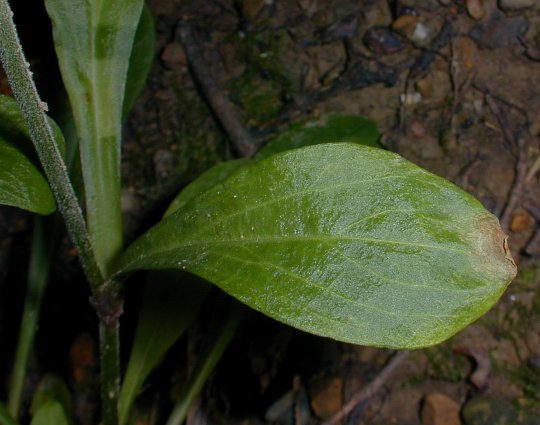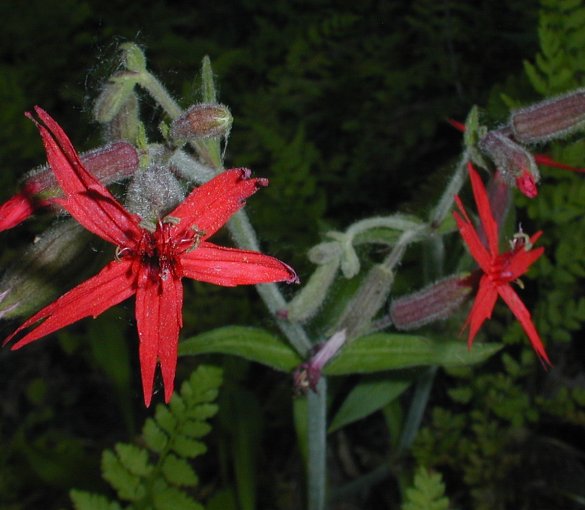Description: This herbaceous plant is ½–2' tall and more or less erect. It branches at the base, where a tuft of basal leaves occurs, and toward the apex of the stems, where the flowers occur. The stems are terete and quite pubescent. The basal leaves and lower cauline leaves are up to 6" long and 1" across. They are medium to dark green, oblanceolate, and smooth along their margins. Each of these leaves tapers gradually to a petiole-like base. The upper cauline leaves are lanceolate or oblong, sessile, and smaller in size, otherwise they are similar to the lower leaves. The cauline leaves occur in opposite pairs along the stems; there are usually 2-4 pairs of cauline leaves per stem (rarely more). Young leaves are often finely pubescent, but they become nearly hairless with age. Each of the upper stems terminates in a cyme of 3-10 flowers; both the branches and pedicels of each cyme are terete and quite pubescent. The flowers are loosely arranged in each cyme, which is often wider than it is tall.

Each flower
is about ¾–1" long and 1–1½" across, consisting of 5 spreading red
petals, a tubular green calyx, 10 stamens, and 3 styles. The petals are
rather narrow and notched at their tips; at the base of each petal,
there is a pair of small red teeth. The tubular calyx has several
ridges along its length and several small teeth along its outer rim.
The outer surface of this calyx is densely covered with a glandular
pubescence that has a sticky texture. The blooming period occurs from
late spring to mid-summer and lasts about 1½ months. Each flower is
replaced by a seed capsule with 6 small teeth along its upper rim. It
is broader toward the top than the bottom, and contains several seeds.
Each seed is somewhat flattened and orbicular-reniform in shape; its
surface is warty or pebbly. The root system consists of a taproot with
secondary roots.
Cultivation:
The preference is partial sun, mesic to dry conditions, and a
rather poor soil containing too much sand, clay, or rocky material.
Fire Pink can be short-lived as a perennial, but it occasionally
reseeds itself.

Range &
Habitat:
The native Fire Pink is an uncommon plant that occurs in scattered
areas of NE,
central, and southern Illinois (see Distribution
Map). Occasionally, small colonies of this species are
discovered in new areas, although its population within the state isn't
expanding. Habitats include openings in upland woodlands, rocky wooded
slopes, thinly wooded
bluffs, limestone and sandstone cliffs, and clay banks along trails in
wooded areas. Fire Pink often occurs along slopes and barren areas
where there is scant ground vegetation. Populations of this species
will decline if the overhead canopy of trees becomes too dense; some
disturbance from fire and other causes is probably beneficial.
Faunal Associations:
Little information is available about floral-faunal relationships. The
flowers are probably cross-pollinated by the Ruby-throated Hummingbird
and various large butterflies, which seek nectar from the flowers. The
sticky hairs on the surface of the calyx discourage ants from climbing
up the flower to steal nectar.

Photographic
Location:
The upper slope of a
wooded bluff in Vermilion County, Illinois, and a clay embankment along
a trail in a wooded
area of the same county.
Comments:
Fire Pink produces spectacular red flowers. For some reason, it is not
often seen in flower gardens, where introduced Pink species are
typically grown. Another native species that occurs in Illinois, Silene
regia (Royal Catchfly), has a somewhat similar appearance
with striking red flowers, but it has 8 or more pairs of leaves along
its stems and the tips of its petals are not notched. An introduced
species with red flowers, Lychnis chalcedonica
(Maltese Cross), is occasionally grown in flower gardens, from which it
rarely escapes. Its flowers have petals that are even more deeply
notched than those of Fire Pink. Maltese Cross produces its flowers in
a dense globoid cluster at the apex of its central stem, and its
ovate-lanceolate leaves are much broader at the base than those of Fire
Pink.